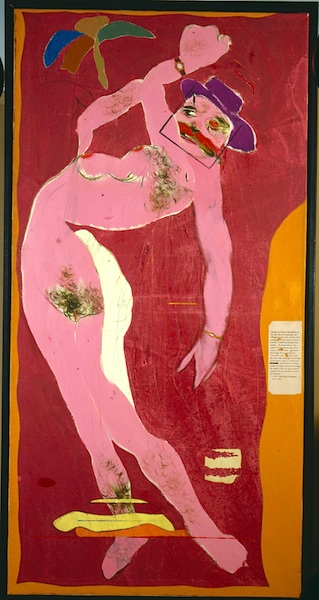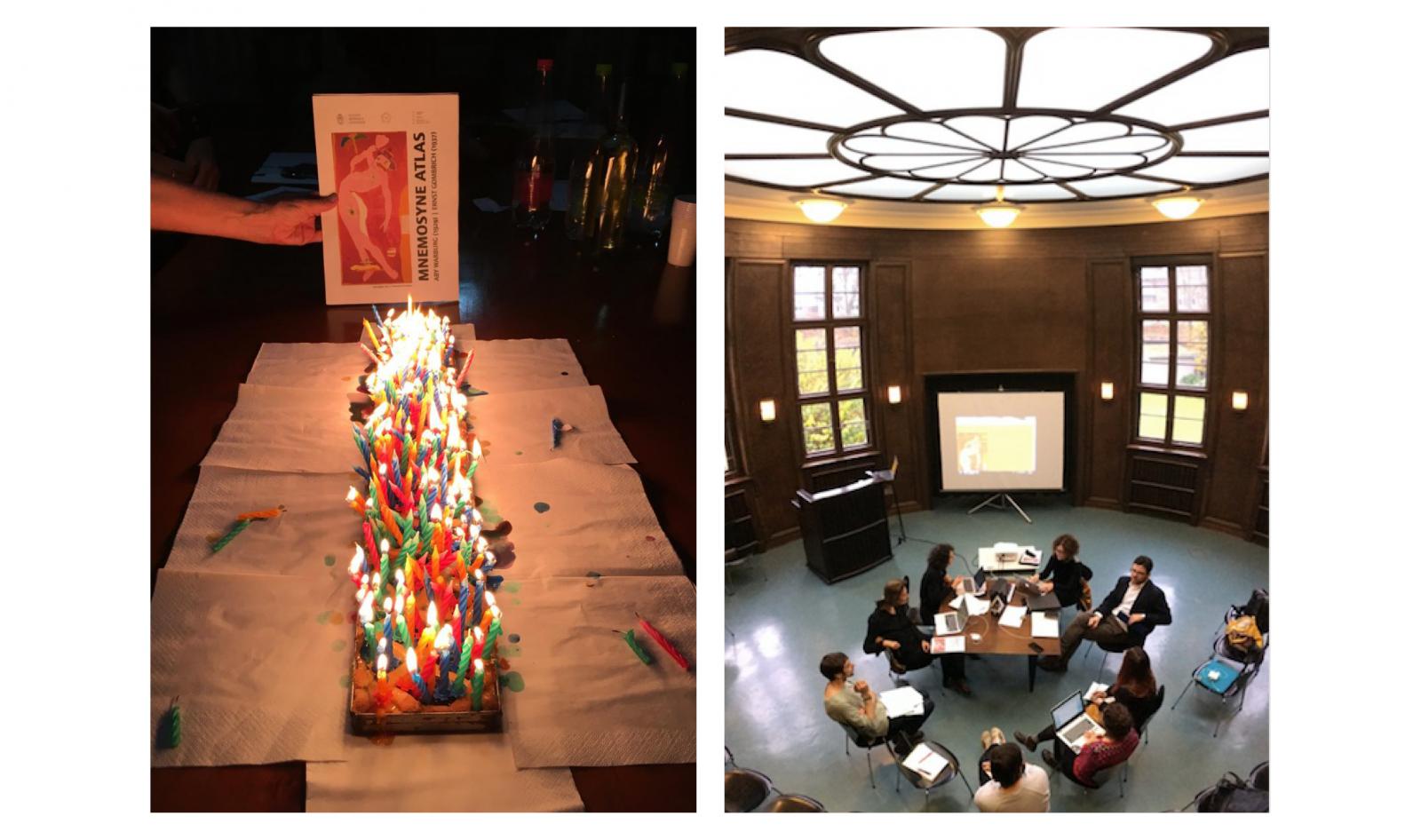
Ronald B. Kitaj, Warburg as Maenad, olio e collage su tela, 1961-1962, Stiftung Museum Kunstpalast, Düsseldorf.
Engramma 151 è dedicato al rapporto tra Ernst H. Gombrich e Aby Warburg, misurato su un oggetto preciso: la tormentata vicenda editoriale del Mnemosyne Atlas.
Alla sua morte, nell’ottobre del 1929, Aby Warburg lasciava incompiuto lo straordinario progetto del Bilderatlas, del quale era imminente la pubblicazione per l’editore Teubner (sul tema v., in Engramma, la presentazione di Mnemosyne). Giorgio Pasquali nel 1930 scriveva che l’Atlante era “pronto per la pubblicazione” e che la sua edizione avrebbe cambiato la storia degli studi e della divulgazione delle ricerche in campo umanistico (v. G. Pasquali, Ricordo di Aby Warburg, “Pegaso” II/4 (1930), 484-495; ed. digitale: “La Rivista di Engramma” 25, maggio/giugno 2003). Com’è noto, il grande progetto di Warburg resta sospeso per due ragioni: la morte del suo ‘regista’ e le concomitanti vicende storiche (la migrazione a Londra dell’Istituto Warburg a seguito dell’avvento al potere in Germania del partito nazionalsocialista).
Nel 1937, a Londra, il giovane Ernst Gombrich, entrato da poco a far parte del Warburg-Kreis, in occasione del settantesimo compleanno di Max Warburg, aveva l’incarico di confezionare un’edizione privata del Bilderatlas: il Geburtstagsatlas für Max M. Warburg. L’operazione, pensata come un dono privato, prese l’avvio con tutta probabilità per sollecitazione di Gertrud Bing e di Fritz Saxl, ovvero dello stesso Max: va comunque incontro a un desiderio della famiglia che continuava a credere nella possibilità di un esito editoriale dell’‘impresa Mnemosyne’. Conservato in due copie dattiloscritte – una presso il Warburg Institute di Londra, una al Warburg-Haus di Amburgo – il Geburtstagsatlas, è rimasto per decenni nell’oblio ed è a tutt’oggi inedito (v. la pagina dedicata nel sito The Warburg Institute).
L’operazione di Gombrich è molto netta: seleziona 24 tavole delle 63 presenti nell’ultima versione del Mnemosyne Atlas del 1929; da ciascuna di esse elimina diversi materiali; impagina su fondo bianco, in modo ordinato, composto e gerarchico le immagini superstiti, modificando decisamente relazioni spaziali e formati; a ognuna delle 24 tavole affianca una succinta spiegazione, una sorta di lunga didascalia, che dà il senso del ‘tema’ della tavola. Alla sua versione dell’Atlas premette una breve e densa Introduzione: pur avendo a disposizione l’Einleitung al Mnemosyne Atlas che Warburg aveva redatto nel 1929, Gombrich si discosta in modo reciso, sul piano concettuale e terminologico, dall’impostazione che lo studioso amburghese aveva voluto per il suo opus.
Lo studio del Geburtstagsatlas permette di gettar luce sulle premesse della riflessione teorica di Gombrich su Warburg, confluite nel celebre Aby Warburg: An Intellectual Biography del 1970 (sulla biografia di Gombrich, v. in Engramma Aby Warburg e i suoi biografi, “La Rivista di Engramma” 1, settembre 2000; la recensione critica di Guglielmo Bilancioni all’edizione italiana Feltrinelli del 1983, “La Rivista di Engramma” 34, giugno/luglio 2004; l’Introduzione alla nuova edizione Feltrinelli 2003, “La Rivista di Engramma” 24, aprile 2003; v. inoltre la recensione di Edgar Wind pubblicata in “The Times Literary Supplement”, 25 June 1971, 735-736, ripubblicata con note ed integrazioni dalle carte di Wind in E. Wind, The Eloquence of Symbols. Studies in Humanist Art, Oxford 1983, 106-113, tr. it. di E. Colli in E. Wind, L’eloquenza dei simboli, Milano 1992, 161-173).
Engramma 151 presenta: una prima edizione digitale del Geburtstagsatlas für Max M. Warburg di Gombrich, composta dalla collazione dei due esemplari dattiloscritti presenti al Warburg Institute di Londra e al Warburg-Haus di Amburgo; il testo originale tedesco e la traduzione italiana dell’Einleitung di Ernst Gombrich al Geburtstagsatlas con Note e appunti di lessico, a cura del Seminario Mnemosyne, dai quali si evincono le diverse impostazioni di pensiero sottese alle due introduzioni, e quindi elementi per un primo confronto tra il metodo di Warburg e quello di Gombrich; il saggio di Victoria Cirlot sui concetti di Zwischenraum/Denkraum, fondamentali nell’Introduzione al Mnemosyne Atlas di Warburg, che Gombrich scotomizza (già in versione originale spagnola in “La Rivista di Engramma” 150, ottobre 2017); Esercizi di confronto tra le Tavole 7, 30, 37 del Geburtstagsatlas di Gombrich, e le corrispondenti del Mnemosyne Atlas, di Salvatore Settis, Alessandra Pedersoli, Simone Culotta; il contributo di Matias J. Nativo e Alessia Prati su Ronald Brooks Kitaj, autore di un ritratto di Ernst Gombrich (rifiutato dallo stesso) e del ritratto di ‘Warburg come menade’, adottato come immagine di copertina di questo numero di Engramma. In chiusura l’aggiornamento della bibliografia warburghiana a cura di Marilena Calcara e Monica Centanni, Bibliography. Works by Aby Warburg and secondary literature (updated October 2017).
I materiali presentati in questo numero sono frutto del lavoro del Seminario itinerante che negli ultimi tre anni ha fatto tappa al Centro studi classicA, Università Iuav di Venezia (I tappa, 2014; II tappa, 2015); al Warburg-Haus, Hamburg (III tappa, 2015); alla Scuola Normale Superiore di Pisa (IV tappa, 2016); all’Universitat Pompeu Fabra, Barcelona (V tappa, 2017); al Palazzone di Cortona, Scuola Normale Superiore (VI tappa, 2017); al Warburg-Haus, Hamburg (VII tappa, 2017).

Warburgwandergelehrten Seminar:
a sin. Palazzone di Cortona, Scuola Normale Superiore, 13 giugno 2017.
a dex. Warburg-Haus, Hamburg, 27 novembre 2017.
Mnemosyne Challenged
Editorial paper of Engramma No. 151
Monica Centanni and Anna Fressola
English version

Ronald B. Kitaj, Warburg as Maenad, oil and collage on canvas, 1961-1962, Stiftung Museum Kunstpalast, Düsseldorf.
When he died, in October 1929, Aby Warburg left unfinished the extraordinary project of the Bilderatlas which was soon to be published by Teubner (see, in Engramma, the presentation of Mnemosyne Atlas). Giorgio Pasquali wrote in 1930 that the Atlas was “ready for publication”, and that its publication would change the history of studies and dissemination of research in the humanistic field (see: G. Pasquali, A tribute to Aby Warburg, Eng. trans. by E. Thomson, “La Rivista di Engramma” 114, March 2014).
As we know, Warburg’s great project was suspended for two reasons: the death of its ‘director’, and the contemporary historical events (the emigration of the Warburg Institute to London because of the Nazi Party’s rise to power in Germany).
In 1937, Ernst H. Gombrich, who had just joined the Warburg-Kreis in London, was commissioned to produce a private edition of the Bilderatlas: Geburtstagsatlas für Max M. Warburg, to celebrate the seventieth birthday of Aby Warburg’s brother. The operation, conceived as a private gift, was probably initiated by Gertrud Bing and Fritz Saxl, or Max himself: the undertaking was intended to satisfy the family’s wishes as they continued to believe that the Mnemosyne project could be published. Preserved in two typewritten copies – one kept in London, the other in Hamburg – the Geburtstagsatlas was for decades consigned to oblivion and still remains unpublished (see the dedicated page on The Warburg Institute website).
Gombrich’s modus operandi is very clear: he selects 24 panels (out of the 63 of the last version of the Bilderatlas of 1929); removes many images from each of the panels; lays out the surviving images on a white background, in a well-balanced and hierarchical order, by modifying original formats and space relations; each of the 24 panels is furnished with a brief but condensed explanation of its main topics. Gombrich introduces his version of the Atlas with a short but charged premise; although a copy of the Einleitung to Mnemosyne written by Warburg in 1929 was available to him, he firmly disassociated himself from it, both formally and conceptually.
An analysis of Gombrich’s Geburtstagsatlas makes it possible to throw light on the introduction to his theoretical reflections on Warburg that would be included in his seminal publication: Aby Warburg: An Intellectual Biography (London 1970). On Gombrich’s biography, see in Engramma, Aby Warburg and his biographers. An intellectual portrait in the words of Giorgio Pasquali (1930), Gertrud Bing (1958), Edgar Wind (1970) (originally published in “La Rivista di Engramma” 1, September 2000; re-issued in November 2012); the critical review of the Italian edition (Feltrinelli, Milano 1983) by Guglielmo Bilancioni (“La Rivista di Engramma” 34, June/July 2003), and the Introduction to the new Feltrinelli edition (Milano 2003; in “La Rivista di Engramma” 24, April 2003). See also the review by Edgar Wind published in “The Times Literary Supplement”, 25 June 1971, 735-736, and republished with Notes and references, added from Wind’s papers, in the essay collection The Eloquence of Symbols (Oxford 1983), 106-113.
Engramma No. 151 presents: the first digital edition of Gombrich’s Geburtstagsatlas für Max M. Warburg, from the collation of the two typewritten copies of the document, preserved at he Warburg Institute in London and the Warburg-Haus in Hamburg; the original German text with a traslation into Italian of Gombrich’s Introduction to the Geburtstagsatlas edited by Seminario Mnemosyne, which highlights their different ways of thinking, and elements for a first attempt to compare Warburg’s methodology with Gombrich’s; the essay by Victoria Cirlot on the concepts of Zwischenraum/Denkraum, fundamental terms in Warburg’s Introduction to Mnemosyne Atlas, scotomised by Gombrich (see the original text in Spanish in “La Rivista di Engramma” 150, October 2017); three comparison exercises between Panels 7, 30 and 37 of Mnemosyne Atlas by Aby Warburg & collaborators (1929) and the corresponding Gombrich’s versions (1937), by Salvatore Settis, Alessandra Pedersoli, Simone Culotta; the essay by Matias J. Nativo and Alessia Prati on Ronald Brooks Kitaj, author of a protrait of Ernst Gombrich, rejected by Gombrich himself, and of the painting Warburg as Maenad, adopted as the cover image of this issue of Engramma. To conclude we publish the Bibliography. Works by Aby Warburg and secondary literature, an updated bibliography of both primary and secondary literature on Warburg, by Marilena Calcara and Monica Centanni.
Finally, it should be remembered that the materials presented in this Issue are the result of the work of the itinerant Seminar which in the last three years has spent two stages at classicA, Iuav University of Venice (1st stage 2014, 2nd stage 2015); Warburg-Haus in Hamburg (3rd stage 2015); Scuola Normale Superiore di Pisa (4th stage 2016); Pompeu Fabra Universitat in Barcelona (5th stage 2017); Palazzone di Cortona, Scuola Normale Superiore (6th stage 2017); Warburg-Haus, Hamburg (7th stage 2017).

Warburgwandergelehrten Seminar:
left: Palazzone di Cortona, Scuola Normale Superiore, 13 June 2017.
right: Warburg-Haus, Hamburg, 27 November 2017.
To cite this article: M. Centanni, A. Fressola, Mnemosyne contesa. Engramma 151, Editorial, “La Rivista di Engramma” n. 151, novembre-dicembre 2017, pp. 7-10 | PDF